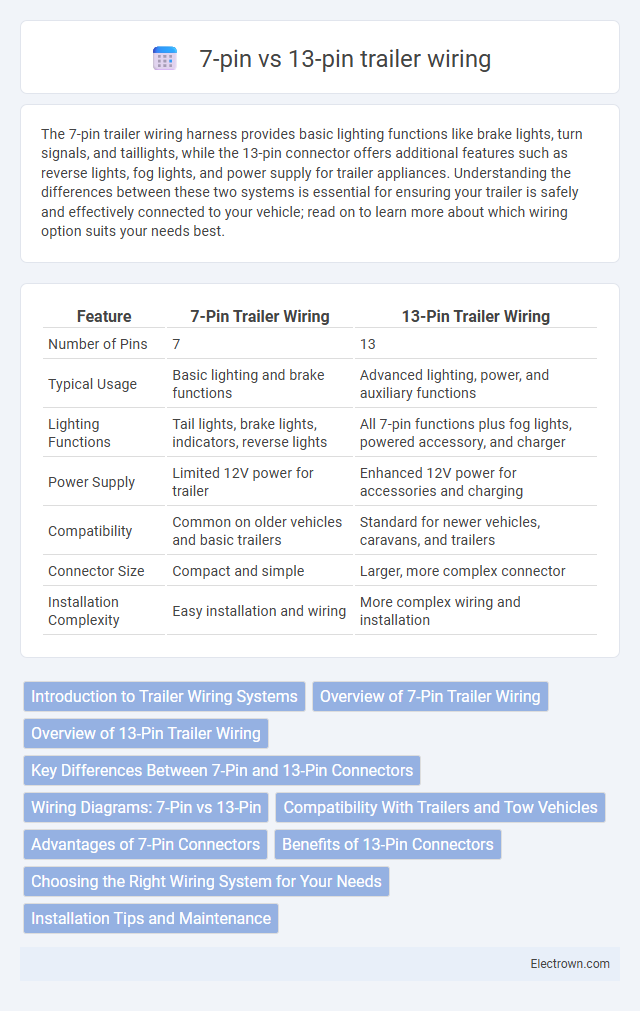The 7-pin trailer wiring harness provides basic lighting functions like brake lights, turn signals, and taillights, while the 13-pin connector offers additional features such as reverse lights, fog lights, and power supply for trailer appliances. Understanding the differences between these two systems is essential for ensuring your trailer is safely and effectively connected to your vehicle; read on to learn more about which wiring option suits your needs best.
Table of Comparison
| Feature | 7-Pin Trailer Wiring | 13-Pin Trailer Wiring |
|---|---|---|
| Number of Pins | 7 | 13 |
| Typical Usage | Basic lighting and brake functions | Advanced lighting, power, and auxiliary functions |
| Lighting Functions | Tail lights, brake lights, indicators, reverse lights | All 7-pin functions plus fog lights, powered accessory, and charger |
| Power Supply | Limited 12V power for trailer | Enhanced 12V power for accessories and charging |
| Compatibility | Common on older vehicles and basic trailers | Standard for newer vehicles, caravans, and trailers |
| Connector Size | Compact and simple | Larger, more complex connector |
| Installation Complexity | Easy installation and wiring | More complex wiring and installation |
Introduction to Trailer Wiring Systems
Trailer wiring systems consist primarily of 7-pin and 13-pin connectors, each designed to establish electrical connections between the towing vehicle and the trailer for functions such as lighting, indicators, and braking systems. The 7-pin connector is commonly used for basic trailer lighting and simple electrical needs, while the 13-pin connector supports additional features including reverse lights, power supply to the trailer's onboard systems, and more reliable connections with improved corrosion resistance. Understanding these wiring systems ensures compatibility, safety, and efficient operation when towing different types of trailers.
Overview of 7-Pin Trailer Wiring
7-pin trailer wiring is a common standard designed to connect basic lighting functions such as tail lights, brake lights, and turn signals between your vehicle and trailer. It includes one pin dedicated to reversing lights and another for the trailer's electric brake system, making it suitable for a variety of trailers, including caravans and horse trailers. This wiring setup prioritizes essential safety signals while maintaining a straightforward installation and compatibility with many towing vehicles.
Overview of 13-Pin Trailer Wiring
The 13-pin trailer wiring system provides enhanced connectivity for modern trailers by supporting additional functions such as reverse lights, permanent power, and interior trailer lighting, unlike the simpler 7-pin setup. This advanced wiring harness ensures safer, more reliable towing with improved signal clarity and power distribution. Your trailer's functionality and compliance with current regulations are better maintained with the versatile 13-pin configuration.
Key Differences Between 7-Pin and 13-Pin Connectors
The 7-pin trailer wiring connector primarily supports basic lighting functions such as brake lights, turn signals, and tail lights, while the 13-pin connector includes additional pins for reverse lights, electric brakes, and a constant power supply for accessories. You will find the 13-pin design offers enhanced security and improved weather resistance through a more robust connection system, reducing the risk of disconnection and corrosion. Choosing between these connectors depends on your trailer's electrical requirements, with the 13-pin providing greater versatility for modern towing needs.
Wiring Diagrams: 7-Pin vs 13-Pin
Trailer wiring diagrams for 7-pin and 13-pin connectors differ mainly in complexity and functionality, with the 7-pin providing basic lights and brake connections, while the 13-pin supports additional features like reverse lights and a continuous power supply. The 7-pin system uses circular pins arranged to handle stop, tail, indicator, and earth functions, ideal for smaller trailers or older vehicles. Your choice between 7-pin and 13-pin wiring diagrams should align with the electrical demands of your trailer, ensuring proper compatibility and safety.
Compatibility With Trailers and Tow Vehicles
Trailer wiring 7-pin connectors primarily support basic lighting and braking functions, making them compatible with most standard trailers and older tow vehicles. In contrast, 13-pin connectors offer enhanced compatibility by supporting additional features such as reverse lights, electric handbrakes, and power supply for caravan appliances, which are essential for modern tow vehicles and caravans. Choosing the correct wiring system ensures seamless integration and safety between the tow vehicle and trailer electrical systems.
Advantages of 7-Pin Connectors
7-pin trailer connectors offer simplicity and widespread compatibility, making them ideal for standard towing needs. They provide essential functions such as brake lights, indicators, and a 12V supply, ensuring reliable basic trailer operation. Your trailer benefits from easy installation and maintenance due to the connector's straightforward design and robust construction.
Benefits of 13-Pin Connectors
The 13-pin trailer connector offers enhanced functionality by providing additional circuits for reversing lights, fog lights, and a constant power supply, which 7-pin connectors lack. This leads to improved safety and convenience, especially for complex trailers with multiple electrical needs such as caravans or horseboxes. Your trailer setup benefits from greater reliability and comprehensive lighting control with the 13-pin system.
Choosing the Right Wiring System for Your Needs
Selecting between a 7-pin and 13-pin trailer wiring system depends on the complexity of your trailer's electrical requirements. A 7-pin connector typically supports basic functions such as tail lights, brake lights, and turn signals, making it ideal for simpler trailers or older vehicles. A 13-pin system offers additional capabilities including reverse lights, fog lights, and a continuous power supply for internal trailer appliances, providing enhanced safety and convenience for modern towing needs.
Installation Tips and Maintenance
When installing a 7-pin or 13-pin trailer wiring system, ensure connectors are securely fastened and match your vehicle's socket to prevent electrical faults. Regularly inspect pins for corrosion, clean contacts with electrical cleaner, and apply dielectric grease to maintain optimal conductivity and prolong connector life. You can improve reliability by checking wiring harnesses for damage and ensuring proper grounding connections on your trailer.
Trailer wiring 7-pin vs 13-pin Infographic

 electrown.com
electrown.com